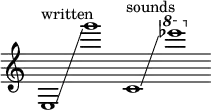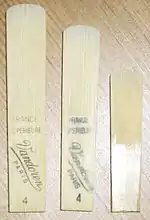A-flat clarinet
The A-flat (A♭) clarinet is the most common member of the highest-pitched instruments of the clarinet family. It is just over half the length of the common B♭ clarinet, and pitched a minor seventh higher, a perfect fourth higher than the E♭ clarinet. As a transposing instrument it sounds a minor sixth higher than written, thus the lowest written note E3 sounds as concert C4 (middle C).
 A♭ clarinet | |
| Woodwind instrument | |
|---|---|
| Classification | Single-reed |
| Hornbostel–Sachs classification | 422.211.2–71 (Single-reeded aerophone with keys) |
| Playing range | |
 | |
| Related instruments | |
| Musicians | |
| Clarinetists | |
| Builders | |
| |
| More articles or information | |
| Clarinet family | |
History of small clarinets
The clarinets pitched higher than the C clarinet are frequently taken together as a group, variously known as the "sopranino/piccolo" (Shackleton, Lawson),[2][3] "small" (Baines, Rice),[4][5], or "high" (Tschaikov) clarinets.[6] They are known as piccolo in Italian, petite in French, and kleine in German, which are all words for "small".[5]
The group contains clarinets built in several pitches, the largest being the sopranino clarinets in D and E♭, to the smallest in high A, B♭ and C, sometimes called "octave" clarinets, built an octave above the more common instruments in those keys. British organologist Albert Rice in his 2017 survey counted eleven pitches of high clarinets, but noted that while the D♭ soprano and sopraninos in E and G♭ are mentioned in literature and catalogs, no known instruments in these pitches exist in museums or private collections.[7]
Of the three highest and smallest "octave" clarinets, the A and B♭ clarinets found some use in 19th century Prussian and Russian military bands, while the smallest, in C, was probably experimental, only found with simplified key work due to the tight fingering required of an instrument only 28 centimetres (11 in) long.[8] Above the E♭ sopranino clarinet and below the octave clarinets, this leaves three small clarinets, in F, G, and A♭.
The F clarinet was used mainly in military bands from around 1780 until the mid-19th century; French composer Hector Berlioz noted in his 1843 landmark Treatise on Instrumentation that it had been all but replaced by the E♭ clarinet.[9] British composer and musicologist Cecil Forsyth in his 1914 orchestration treatise associated the high clarinets with Austria, saying "Clarinets in (high) F, and even in (high) A♭ are occasionally used abroad. The latter instrument is regularly employed in the Austrian military bands."[10]
The G clarinet found some brief fame in Viennese small ensembles, particularly the Schrammelmusik of 1880s Vienna, where it gained the nickname pickstisses Holzl, possibly Viennese slang for "fabulous matchstick".[11] The music was originally performed by a quartet of two violins (the brothers Johann and Josef Schrammel), a contraguitar, and the G clarinet played by Georg Dänzer. It was first recorded by players of the Vienna Philharmonic, with principal clarinet Richard Schönhofer playing the high G clarinet, after the original parts were found in the 1960s.[12][13]
The A♭ clarinet first appeared in the early 19th century and was adopted mainly by European wind bands. It survived in military bands, particularly in Spain and Italy, at least through the middle of the 20th century.[14] It has found a niche in contemporary art music and clarinet choirs, and the A♭ and G clarinets are the only sizes of clarinet higher than the E♭ sopranino still manufactured.
Construction


The A♭ clarinet, as is usual with other small clarinets, is constructed with a one-piece body, rather than the separate upper and lower joints found on larger clarinets, or even the separate barrel of the E♭ clarinet. This is due to its small size and more compact key work. The bell and mouthpiece are still generally separate.
At least three manufacturers currently produce A♭ clarinets: Italian makers L. A. Ripamonti and Orsi, and Schwenk & Seggelke in Germany.[1] Prior to their acquisition by Conn-Selmer in 2004, Leblanc also made an A♭ clarinet.[15] Ripamonti and Schwenk & Seggelke prodcuce A♭ clarinets with German and French system key work, and Schwenk & Seggelke also make a German system G clarinet.
Repertoire
The A♭ clarinet initially found its widest use in 19th century European wind and military band music, where it often doubled the piccolo line.[14] Italian opera composer Giuseppe Verdi wrote for the instrument in the stage band parts for his operas Ernani (1844), La traviata (1853), and Un ballo in maschera (1859).[16]
The A♭ clarinet has appeared occasionally in 20th-century music. Béla Bartók wrote for it in his 1905 Scherzo for Piano and Orchestra op. 2 ("mostly in unison with the E♭ or piccolo [flute]").[17][18] Dutch composer Matthijs Vermeulen's Fourth Symphony, published in 1941, includes a part for A♭ clarinet, as does the 1969 Celtic Requiem by English choral composer John Tavener.[19] German avant-garde composer Hans-Joachim Hespos uses the A♭ clarinet in his 1972 large orchestral work, Interactions.[20] Several of his chamber works also employ the A♭ clarinet; his 1978 work go also includes soprano sarrusophone, heckelphone, and tárogató.[21]
The A♭ clarinet is not uncommon in clarinet choir arrangements—for instance, those of Lucien Cailliet, including Mozart's Marriage of Figaro overture—though the instrument is often optional or cued in other voices.
Contemporary works
- John Tavener – Celtic Requiem (1969)
- Hans-Joachim Hespos – Interactions (1972)
- Samuel Andreyev – Vérifications for six instruments (2012)[22]
References
-
"317 Ripa – Clarinetto Piccolo La♭. 17/6 Boehm, Ripa serie" (in Italian). Milan: L. A. Ripamonti. Retrieved 21 April 2023.
"Prodotti" [Products] (in Italian). Milan: Prof. Romeo Orsi S.R.L. Retrieved 29 August 2023.
"Clarinet models 1000/1000+/3000". Bamberg: Schwenk & Seggelke. Retrieved 29 August 2023. - Shackleton 2001, 1. The clarinet family.
- Lawson 1995, p. 33.
- Baines 1977, p. 123–125.
- Rice 2017, p. 135.
- Tschaikov 1995, p. 43.
- Rice 2017, p. 136.
- Rice 2017, p. 136–138.
- Rice 2017, p. 144–145.
- Forsyth 1914, p. 281.
- Tschaikov 1995, p. 53.
- Böck, Lois (conductor); Das Klassische Wiener Schrammelquartett (1966). "Schrammeln (Die Originalmusik Der Brüder Schrammel)". Decca. SLK 16397-P. Retrieved 27 August 2023 – via Discogs.
{{cite web}}: CS1 maint: multiple names: authors list (link) - Klassisches Wiener Schrammelquartett. Wiener Typen Marsch (Audio recording). Retrieved 27 January 2023 – via YouTube.
- Baines 1977, p. 124.
- "Ab Piccolo (sopranino) clarinet". The Clarinet BBoard. 18 June 2003. Retrieved 27 August 2023.
Post by diz: "I just contacted Leblanc's Sydney agent ... it is now a discontinued model (1176AbS)"
- Tschaikov 1995, p. 54.
- Mason, Colin (1963). "Bartók's Scherzo for Piano and Orchestra". Tempo (65): 10–13. doi:10.1017/S0040298200055844.
- Tschaikov 1995, p. 53–55.
- "Symfonie nr4 – partituur netschrift". Matthijs Vermeulen. Archived from the original on 30 July 2018. Retrieved 27 August 2023.
- "Complete work (engl.) – Orchestral works". Hans-Joachim Hespos website. Retrieved 7 February 2007.
- "Complete work (engl.) – Ensemble works". Hans-Joachim Hespos website. Retrieved 7 February 2007.
- "Vérifications for six instruments". Samuel Andreyev. 2012. Retrieved 28 August 2023.
Bibliography
- Baines, Anthony (1977). Woodwind Instruments and their History (3rd ed.). New York: Dover Publications (published 1991). ISBN 978-0-48626-885-9. OCLC 24010861. OL 1544645M. Wikidata Q115155619.
- Forsyth, Cecil (1914), Orchestration, London: Macmillan Publishers, LCCN a14002863, OCLC 408500, Wikidata Q121879329
- Lawson, Colin (1995). "3. The clarinet family. Introduction: clarinets in B♭ and A". In Lawson, Colin (ed.). The Cambridge Companion to the Clarinet. Cambridge Companions. Cambridge: Cambridge University Press. p. 33–37. doi:10.1017/CCOL9780521470667. ISBN 978-1-139-00205-9. OL 1121104M. Wikidata Q116448371.
- Rice, Albert R. (March 2017). "Small Clarinets: History, Instruments, and Music". The Galpin Society Journal. 70: 135–68, 230–1. doi:10.2307/45200834. JSTOR 45200834.
- Shackleton, Nicholas (2001). "Clarinet: II. The clarinet of Western art music". Grove Music Online (8th ed.). Oxford University Press. doi:10.1093/gmo/9781561592630.article.52768. ISBN 978-1-56159-263-0. Retrieved 27 January 2023.
- Tschaikov, Basil (1995). "The high clarinets". In Lawson, Colin (ed.). The Cambridge Companion to the Clarinet. Cambridge Companions. Cambridge: Cambridge University Press. p. 43–56. doi:10.1017/CCOL9780521470667. ISBN 978-1-139-00205-9. OL 1121104M. Wikidata Q116448371.